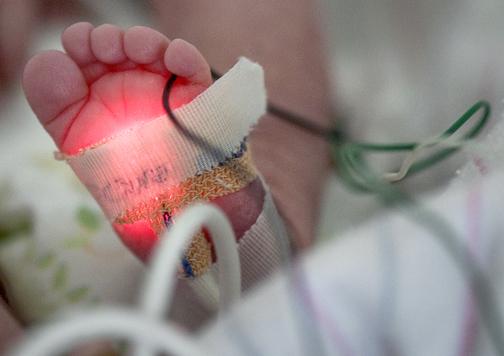Another underwater birth, another near-fatal consequence. This time the imperiled, septic newborn endured unnecessary multi-organ failure that necessitated a two-month hospitalization in the intensive care unit (ICU).
The case of this infant was published yesterday in the Canadian Medical Association Journal (CMAJ). To appreciate the life-threatening clinical picture and need for aggressive intervention, I have highlighted some essential facts of the patient’s course (obtained and abridged from this CMAJ link):
- Infant born at home in hot tub that was pre-filled for 3 days prior to delivery.
- On day of life #8 when first evaluated for care, the baby girl had 1 day of fever, poor feeding, and fussiness. She had fever of 102.4 degrees Fahrenheit, a rapid heart rate and increased work of breathing. Chest X-ray demonstrated right upper lobe pneumonia.
- Later that day she deteriorated expeditiously and was transferred to ICU needing intubation, ultimately on a mechanical ventilator for 5 weeks.
- She was in multi-organ failure, had blood cell abnormalities and hemodynamic instability (aka septic shock) necessitating powerful continuous intravenous medications to increase her heart's ability to pump (chronotropic agents) and to constrict her blood vessels so that they would deliver oxygen and nutrients more effectively (pressor agents).
- Treated with or exposed to:
- ampicillin, cefotaxime, meropenem, vancomycin, azithromycin, piperacillin-tazobactam (antibiotics)
- acyclovir (anti-viral)
- Rifampin for synergy
- Resuscitative high dose pressors
- Repeated imaging that emits radiation, like computed tomography scan (CT Scan) showing necrotizing pneumonia, multiple procedures etc.
- Culprit: Legionella. Also grew Pseudomonas aeruginosa and Cupriavidus gilardii - known to be in water from birthing pools.
- Discharged on home oxygen and close monitoring
What is Legionnaires’ Disease?
This is a serious, severe type of pneumonia caused by the bacteria Legionella. The lung infection can be treated by antibiotics usually in a hospital setting with the majority of people faring well. Despite that, the CDC estimates 1 in 10 who acquire Legionnaires’ Disease die from it. Most healthy individuals do not contract it when exposed. People most at risk tend to be already at a higher chance of becoming ill (e.g. compromised immunity by medication or disease, over age 50, smokers). Breathing in or aspirating small droplets of Legionella contaminated water triggers this infection. Hot tubs among other man-made water systems tend to be frequent culprits, in particular, when not properly maintained. See here and here to learn more about Legionnaires’ Disease.
Is neonatal legionellosis common? Why is it so dangerous for them?
It is not a common diagnosis in newborns, but cases have been reported in water birth. As per CAMJ, “overall mortality rates in neonates are up to 55% and the disease may be uniformly fatal if untreated.” The high concentration of the bacteria in the water put even an infant with minor aspiration at risk of severe disease. Symptoms of infection routinely appear 3-14 days after the exposure from contaminated water systems, in particular with vulnerable populations.
Signs of water intoxication, aspiration or infection are typically progressive over time. In the newborn period, for instance, a fever of 100.4 or above is considered abnormal. Babies this young have difficulty localizing infection, so are at higher risk for generalized spread of disease. Additionally, they have a less robust immune system using mom’s passive antibodies while they slowly make their own.
In Legionnaires' Disease Latest Worry For Baby After Water Birth, I discuss despite pneumonia and infection being among the litany of known complications following a water birth, the Centers for Disease Control and Prevention (CDC) reported two cases of Legionnaires’ Disease in newborns in Arizona born this way at home. Further investigation identified another Legionellosis death of an infant after a water birth in 2014 in Texas.
Proponents of water birth rely on claims that a protective primitive reflex prevents such aspiration by the infant until the umbilical cord is cut. Evidence has shown that that reflex can be overridden. Given that both of these cases experienced Legionnaires’ Disease, this theory gets further undermined. It takes very little volume at that age and size to cause problems. For example, a teaspoon or so of fluid can cause pulmonary edema from drowning.
Why add a risk factor?
The question for expectant parents should always be: If water birth goes awry, can I live with the consequences?
It is important to learn about the risks and benefits of any therapy or procedure—of which with respect to water birth there are no proven medical benefits— before making an informed decision that is best for you and your family. Learn the facts and decide for yourself.
Among the issues babies have suffered:
- The type of brain damage when an infant’s brain does not receive adequate oxygen and blood
- Aspiration
- Radiologic findings of fresh water drowning with pulmonary edema
- Respiratory distress
- Seizures as a result of very low sodium from water intoxication
- Challenges of thermoregulation
- Group B Strep (GBS) meningitis
- Snapped umbilical cords prompting blood loss with the need for transfusion, possible shock, and death.
Maternal risks include: loss of control of blood loss, decreased fetal monitoring, limited alternative analgesia, ineffective contractions, higher risk of infection especially with membrane rupture etc.
Having published a case of a near drowning of an infant via water birth in Neoreviews and written repeatedly on the topic, I suggest you review Just Say No to Water Birth for clarification as well as Water Birth: To Breathe or Not To Breathe? where the focus is on the science behind water birth, reported cases of adverse events and detailing the recommendations of the American College of Obstetricians and Gynecologists and the American Academy of Pediatrics. I also discuss the flawed data advocates cite and provide a more comprehensive understanding of water birth.
Bottom line…
Most viral videos or media reports on the topic neglect to show that when negative outcomes occur they have ranged from significant to catastrophic.
Most babies today are born healthy as a direct result of medical advances (eg. infection control measures). Maternal and infant mortality rates have dramatically improved due to such developments. This is wonderful news. Given the unpredictable scope of childbirth for all parties— mother and baby, why add a risk factor?
Delivery is a dynamic event. Uncomplicated and even low risk pregnancies are not guaranteed to occur without situations warranting intervention. Fortunately, we are more readily identifying problems before they arise, but unexpected issues are par for the course.
Though many have had successful experiences with water birth, the issues that have occurred in infants fall within the extreme end of the spectrum. This case report shows heroic measures were vital to keeping this baby alive. There can be long-term ramifications to such interventions and scope of disease. If it can be avoided, then why take that chance?




